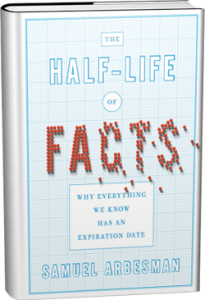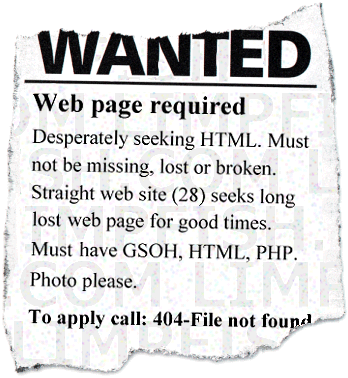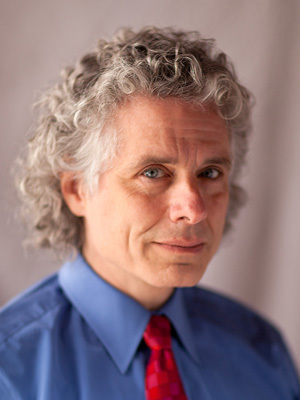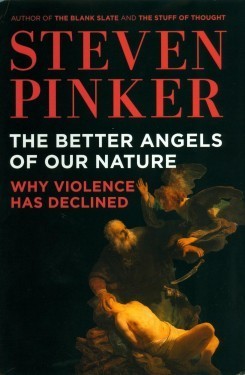Stewart Brand's Blog, page 83
October 2, 2012
Samuel Arbesman Salon Talk, 10/30/12: The Half-Life of Facts
Samuel Arbesman is a mathematician and network scientist who has turned his powerful tools of quantification onto science itself. He’ll discuss his book The Half-Life of Facts at the Long Now Museum & Store on Tuesday, October 30th.
Facts change all the time. Smoking has gone from doctor-recommended to deadly. We used to think the Earth was the center of the universe and that Pluto was a planet. For decades, we were convinced that the Brontosaurus was a real dinosaur. In short, what we know about the world is constantly changing.
But it turns out there’s an order to the state of knowledge, an explanation for how we know what we know. Samuel Arbesman is an expert in the field of scientometrics—literally the science of science. Knowledge in most fields evolves systematically and predictably, and this evolution unfolds in a fascinating way that can have a powerful impact on our lives. – Arbesman.net
This Salon Talk will begin at 6:30pm on October 30th. Long Now Members can RSVP for a complimentary ticket (the code is in your email and our September Quarterly News) and additional tickets are available to the public for $8.

September 30, 2012
Decaying Web
Tom Chatfield from BBC online writes about the newest flavor of the digital dark age… Lost tweets and social media:
On January 28 2011, three days into the fierce protests that would eventually oust the Egyptian president Hosni Mubarak, a Twitter user called Farrah posted a link to a picture that supposedly showed an armed man as he ran on a “rooftop during clashes between police and protesters in Suez”. I say supposedly, because both the tweet and the picture it linked to no longer exist. Instead they have been replaced with error messages that claim the message – and its contents – “doesn’t exist”. [Continue to Article]

September 27, 2012
Worlds: The Kepler Planet Candidates
Worlds: The Kepler Planet Candidates from Alex Parker on Vimeo.
Planetary scientist Alex Parker created an animation of 2,299 extrasolar planet candidates orbiting a single star. NASA’s Kepler mission has detected these transiting planet candidates since 02009.
In reality, these planet candidates aren’t orbiting around a single star, but rather several thousand (some 1,770 sun-like stars). The video above illustrates the candidates by orbital periods, orbital distances and are drawn to scale with accurate radii—they range in size from one-third to 84 times the radius of Earth. Note that the three white rings show the average orbital distances of Mercury, Venus and Earth on the same scale. Side-by-side, we can compare the different orbital distances from planets in our own solar system to those located outside the Milky Way, some of which are approximately 2,000 light years away from Earth.
Parker, a postdoctoral researcher in planetary science at the Harvard-Smithsonian Center for Astrophysics, writes:
The Kepler observatory has detected a multitude of planet candidates orbiting distant stars. The current list contains 2,321 planet candidates, though some of these have already been flagged as likely false-positives or contamination from binary stars. This animation does not contain circumbinary planets or planet candidates where only a single transit has been observed, which is why “only” 2,299 are shown.
While 2,299 may seem to be a lot of potential planets, these candidates were found in what is actually a tiny fraction of the sky (Kepler’s field of view covers approximately 1/400 of the sky). ”In one generation we have gone from extraterrestrial planets being a mainstay of science fiction, to the present, where Kepler has helped turn science fiction into today’s reality,” said NASA Administrator Charles Bolden in a statement back in February 02011. “These discoveries underscore the importance of NASA’s science missions, which consistently increase understanding of our place in the cosmos.”
(via io9)

September 26, 2012
Steven Pinker Seminar Primer
Monday October 8, 02012 at the Herbst Theater, San Francisco
Steven Pinker’s prolific output for both academic and popular audiences has made him one of the most well-known evolutionary psychologists in the world. Trained formally in cognitive psychology, Pinker has tirelessly applied lessons from his groundbreaking research to a better understanding of the roles nature and nurture play in shaping human behaviors like language acquisition and violence. His popular books have taken on broad topics of human nature and explored their evolutionary and psychological roots.
The Language Instinct: How the Mind Creates Language describes how humans learn language and surveys evidence indicating that our unique ability to communicate verbally has evolved to be an innate instinct. Though writing and the specifics of a particular language must be learned, all humans acquire grammar, implying that its basis is genetic and long-standing.
The Blank Slate: The Modern Denial of Human Nature follows a similar line of inquiry, arguing that the human mind is not simply a blank slate onto which society imprints all behavioral characteristics. Evolution has clearly shaped our psychology, Pinker argues, and accepting this fact does not validate racism or social Darwinism. If explored empirically, rather, an understanding of the evolutionary underpinnings of human behavior can lead us to more effective and equitable governance and stronger bonds across cultural differences.
Pinker’s most recent book and the subject of his upcoming lecture, The Better Angels of our Nature: Why Violence has Declined, further unpacks an underlying theme of some of his earlier books. If The Language Instinct proved language is an evolutionary adaptation encoded deep within our biology and The Blank Slate sought to cement the idea that humanity has many characteristics like language that add up to an essential nature that can be empirically understood (even if that nature is often highly customized within particular cultures), The Better Angels of Our Nature continues in this direction by showing that understanding what is essential about that nature and what about it can be culturally modified allows us to more rationally assess and govern ourselves.
In his New York Times review of the book, Peter Singer points out that it might seem strange to hear how humans have changed from someone who has made a name studying how we do not (Pinker once responded to an Edge.org question about how the internet is changing the way he thinks with “Not at all.”), but he explains that Pinker has never argued that nature and nurture are mutually exclusive. Rather, understanding our nature allows us to better nurture the traits we want to emphasize, reason being chief among those because it allows us “to detach ourselves from our immediate experience and from our personal or parochial perspective, and frame our ideas in more abstract, universal terms. This in turn leads to better moral commitments, including avoiding violence.”
Steven Pinker presents the voluminous evidence that we’re becoming more peaceful and explains why on October 8th at the Herbst Theater. You can reserve tickets, get directions and sign up for the podcast on the Seminar page.
Subscribe to the Seminars About Long-term Thinking podcast for more thought-provoking programs.

September 24, 2012
The Earth, Circa 100 Million CE
Yale geology grad student Ross Mitchell and his team are examining a very slow process: the formation, disintegration, and reformation of Earth’s supercontinents. Pangea was the last supercontinent, and certainly the most famous. It formed 300 million years ago. But it wasn’t the first, and won’t be the last. Discover Magazine shares some of Mitchell’s work on describing the next one.
…the researchers first looked back beyond Pangaea and determined the location of supercontinents Rodinia, which formed about a billion years earlier, and Nuna, 700 million years before that. The team found that during the last two cycles, each supercontinent formed a quarter of the way around the globe from where the previous supercontinent had been. Using that insight, they calculated that Amasia will form over the North Pole.
Identifying precisely where the planet’s landmass has been and is going over the course of, say, a billion years, can be tricky. Mitchell’s team recently published findings in Nature magazine that shed light on one of the pieces of the puzzle: paleomagnetism.
Magnetic traces have long been used to calculate the latitudes, the north-south positions, of ancient continents. But longitude, the east-west position, is much trickier to pin down because Earth’s magnetic field varies little with longitude. To overcome the problem, Mitchell and his team devised a new way of analyzing the magnetic data to detect a phenomenon known as true polar wander—the gradual change in the position of Earth’s poles as the planet’s internal mass shifts. By tracking polar wander through time, the researchers were able to determine the longitudinal position of ancient rocks.
You can hear Ross Mitchell talk about his work on NPR’s Talk of the Nation here.

September 19, 2012
Tim O’Reilly Seminar Media
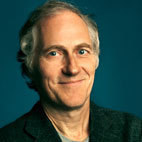 This lecture was presented as part of The Long Now Foundation’s monthly Seminars About Long-term Thinking.
This lecture was presented as part of The Long Now Foundation’s monthly Seminars About Long-term Thinking.
Birth of the Global Mind
Wednesday September 5, 02012 – San Francisco
Audio is up on the O’Reilly Seminar page, or you can subscribe to our podcast.
*********************
Video is up on the O’Reilly Seminar page for Members.
*********************
The global mind is us, augmented – a summary by Stewart Brand
As a student of the classics at Harvard in the 1970s, O’Reilly was impressed by a book titled The Discovery of the Mind: In Greek Philosophy and Literature, by Bruno Snell. In the four centuries between Homer and classical Athens, wrote Snell, the Greeks invented the modern human mind, with its sense of free will and agency. (In Homer, for example, no one makes a decision.) O’Reilly sees a parallel with the emerging of a global mind in this century.
Global consciousness was a recurrent idea in the 1970s—from Teilhard de Chardin’s noosphere and Omega point (“the Singularity of its day”) to “New Age mumbo-jumbo” such as the Harmonic Convergence. O’Reilly noted that the term “singularity” for technology acceleration was first used in 1958 by John von Neumann. In 1960 J.C.R. Licklider wrote an influential paper titled “Human-computer Symbiosis.” O’Reilly predicted that “exploring the possibility space of human-computer symbiosis is one of the fascinating frontiers of the next decades and possibly century.”
Echoing Dale Dougherty, he says the Web has become the leading platform for harnessing collective intelligence. Wikipedia is a virtual city. Connected smart phones have become our “outboard brain.” Through device automation, Apple has imbued retail clerks with superpowers in its stores. Watson, the AI that beat human champions at “Jeopardy,” is now being deployed to advise doctors in real time, having read ALL the scientific papers. YouTube has mastered the attention economy. Humanity has a shared memory in the cloud. Data scientists rule.
The global mind is not an artificial intelligence. It’s us, connected and augmented.
What keeps driving it is the generosity and joy we take in creating and sharing. The global mind is built on the gift culture of every medium of connectedness since the invention of language. You gain status by what you give away, by the value you create, not the value you take.
Subscribe to our Seminar email list for updates and summaries.

Cultural Memories in the Digital World
A book is much more than a collection of information. It is also a physical object, and this materiality plays an important role in shaping the way we relate to literature. Think of how the pages of your favorite story feel between your fingers, and the way its spine creases as you immerse yourself further and further in the plot. The weight of a thick novel reflects the depth of its story, an illustrated cover helps to seed your imagination, while the font in which the text is printed might convey a certain emotional tone. Perhaps you like to record your own thoughts in the white margins of a book’s pages; perhaps you prefer to leave those edges clean and allow the story to stand on its own. Either way, the materiality of a book shapes our relationship to its content; it becomes a physical souvenir of our engagement with a story.
So what happens, then, as our media and the culture they convey move increasingly into the digital world? How does the emergence of e-books change the way we experience a story?
These questions were the subject of a brief talk by publisher and technologist James Bridle, broadcast recently on BBC Radio’s Four Thought. Bridle suggests that the digitization and globalization of our cultural world not only transforms the nature of our cultural artifacts; it changes us, as well.
People are changed by these encounters with the network as much as our cultural objects are. That’s fundamentally important. Even though we’ve always been connected [to the world] in all these ways, the visibility of that connection that the network brings, is deeply strange. You can reach out across space, and you can reach out across time, as well; the network has this extraordinary flattening effect on time, so things that look distant are just as accessible to us as things that are near. And you can see this process happening in the ways that we write, in the ways that we read, and the things that it’s doing to the texts themselves.
Whereas it was the physicality of a book that brought its narrative to life in our experience, it is now the instantaneousness and interactivity of information that facilitate our connection to a story. But while this necessarily changes the way we engage with cultural artifacts, Bridle suggests that this need not entail a loss of value. Our collective cultural memory is not in the process of disappearing; it is simply being transformed – embodied no longer by physical objects, but rather by the process of sharing.

September 12, 2012
Heavy Metal Watchmaking
Hodinkee, an online magazine about wristwatches, has an interview with original Anthrax guitarist Dan Spitz. Why? Because he’s also a master watchmaker who studies and works with the best in the world.
As it turns out, he’s a big fan of timepieces that are built to last:
My favorite stuff to work on is older watches because of how they are made. These watches were way overbuilt so that they would never come back for repair. Just look at the mainplates… They were built at a time before computers were checking everything. If you’ve been working on modern stuff all day, there’s nothing like getting a vintage watch to work on, and when you open it up, you say “Ahhhh, look at that, this rocks!” Like an old muscle car, it’s so basic, so perfect, so overbuilt. It just rocks.

September 10, 2012
Library of Brewer’s Yeast
What the seed vault in Svalbard does for the world’s plants, the Cara Technology’s Research Laboratory in England does for yeast.
The Guardian’s Word of Mouth Blog recently published a feature on this lab’s large collection of brewer’s yeast strains, and its goal of making both classic and custom-made strains available to brewers everywhere.
Most of the world’s beer and wine are made with a single species of yeast: Saccharomyces cerevisiae. But that one species comprises thousands of different families, each with their own characteristic traits – much like the world’s population of Homo sapiens. Since long before Louis Pasteur discovered the actual science behind the magic of fermentation, brewers have been isolating and cultivating these different families to exploit their particular impact on the flavor and qualities of their brews.
Despite brewers’ notorious protectiveness of their yeast cultures, Cara Labs has managed to create a repository for these different families of saccharomyces. They’ve collected and preserved 850 strains, some dating back more than 100 years, and make them available to brewers everywhere. You can find the strains that give Belgian tripels their characteristically smooth and fruity flavor, or the yeast that was used to make German doppelbocks in the late 19th century. And for those brewers who wish to create a style all their own, flavor technology consultants are on hand to assist in identifying the perfect strain of yeast. At Cara Labs, tradition meets innovation in the pursuit of timeless creativity:
“Deep in the corridors of Cara Technology’s research labs in Leatherhead, southern England, a handful of microbiologists and flavour technicians hold both the past and the future of beer drinking in their hands.”

September 8, 2012
Tim O’Reilly Seminar Media
 This lecture was presented as part of The Long Now Foundation’s monthly Seminars About Long-term Thinking.
This lecture was presented as part of The Long Now Foundation’s monthly Seminars About Long-term Thinking.
Birth of the Global Mind
Wednesday September 5, 02012 – San Francisco
Audio is up on the O’Reilly Seminar page, or you can subscribe to our podcast.
*********************
The global mind is us, augmented – a summary by Stewart Brand
As a student of the classics at Harvard in the 1970s, O’Reilly was impressed by a book titled The Discovery of the Mind: In Greek Philosophy and Literature, by Bruno Snell. In the four centuries between Homer and classical Athens, wrote Snell, the Greeks invented the modern human mind, with its sense of free will and agency. (In Homer, for example, no one makes a decision.) O’Reilly sees a parallel with the emerging of a global mind in this century.
Global consciousness was a recurrent idea in the 1970s—from Teilhard de Chardin’s noosphere and Omega point (“the Singularity of its day”) to “New Age mumbo-jumbo” such as the Harmonic Convergence. O’Reilly noted that the term “singularity” for technology acceleration was first used in 1958 by John von Neumann. In 1960 J.C.R. Licklider wrote an influential paper titled “Human-computer Symbiosis.” O’Reilly predicted that “exploring the possibility space of human-computer symbiosis is one of the fascinating frontiers of the next decades and possibly century.”
Echoing Dale Dougherty, he says the Web has become the leading platform for harnessing collective intelligence. Wikipedia is a virtual city. Connected smart phones have become our “outboard brain.” Through device automation, Apple has imbued retail clerks with superpowers in its stores. Watson, the AI that beat human champions at “Jeopardy,” is now being deployed to advise doctors in real time, having read ALL the scientific papers. YouTube has mastered the attention economy. Humanity has a shared memory in the cloud. Data scientists rule.
The global mind is not an artificial intelligence. It’s us, connected and augmented.
What keeps driving it is the generosity and joy we take in creating and sharing. The global mind is built on the gift culture of every medium of connectedness since the invention of language. You gain status by what you give away, by the value you create, not the value you take.
Subscribe to our Seminar email list for updates and summaries.

Stewart Brand's Blog
- Stewart Brand's profile
- 291 followers


